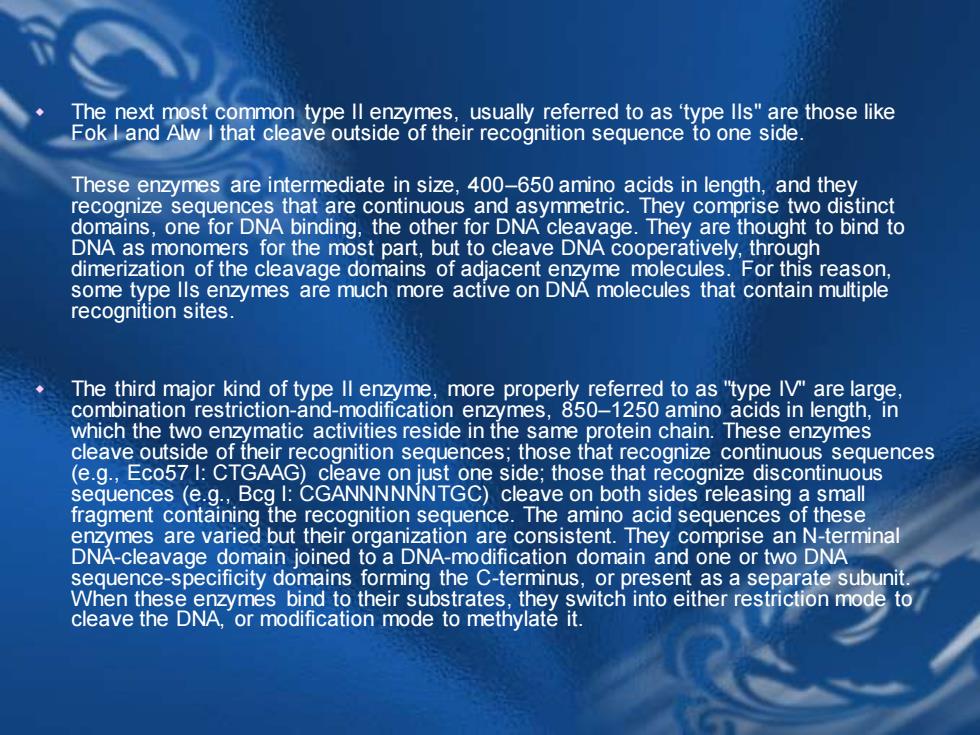正在加载图片...

The next most common type II enzymes, usually referred to as ‘type IIs" are those like Fok I and Alw I that cleave outside of their recognition sequence to one side. These enzymes are intermediate in size, 400–650 amino acids in length, and they recognize sequences that are continuous and asymmetric. They comprise two distinct domains, one for DNA binding, the other for DNA cleavage. They are thought to bind to DNA as monomers for the most part, but to cleave DNA cooperatively, through dimerization of the cleavage domains of adjacent enzyme molecules. For this reason, some type IIs enzymes are much more active on DNA molecules that contain multiple recognition sites. The third major kind of type II enzyme, more properly referred to as "type IV" are large, combination restriction-and-modification enzymes, 850–1250 amino acids in length, in which the two enzymatic activities reside in the same protein chain. These enzymes cleave outside of their recognition sequences; those that recognize continuous sequences (e.g., Eco57 I: CTGAAG) cleave on just one side; those that recognize discontinuous sequences (e.g., Bcg I: CGANNNNNNTGC) cleave on both sides releasing a small fragment containing the recognition sequence. The amino acid sequences of these enzymes are varied but their organization are consistent. They comprise an N-terminal DNA-cleavage domain joined to a DNA-modification domain and one or two DNA sequence-specificity domains forming the C-terminus, or present as a separate subunit. When these enzymes bind to their substrates, they switch into either restriction mode to cleave the DNA, or modification mode to methylate it. The next most common type II enzymes, usually referred to as ‘type IIs" are those like Fok I and Alw I that cleave outside of their recognition sequence to one side. These enzymes are intermediate in size, 400–650 amino acids in length, and they recognize sequences that are continuous and asymmetric. They comprise two distinct domains, one for DNA binding, the other for DNA cleavage. They are thought to bind to DNA as monomers for the most part, but to cleave DNA cooperatively, through dimerization of the cleavage domains of adjacent enzyme molecules. For this reason, some type IIs enzymes are much more active on DNA molecules that contain multiple recognition sites. The third major kind of type II enzyme, more properly referred to as "type IV" are large, combination restriction-and-modification enzymes, 850–1250 amino acids in length, in which the two enzymatic activities reside in the same protein chain. These enzymes cleave outside of their recognition sequences; those that recognize continuous sequences (e.g., Eco57 I: CTGAAG) cleave on just one side; those that recognize discontinuous sequences (e.g., Bcg I: CGANNNNNNTGC) cleave on both sides releasing a small fragment containing the recognition sequence. The amino acid sequences of these enzymes are varied but their organization are consistent. They comprise an N-terminal DNA-cleavage domain joined to a DNA-modification domain and one or two DNA sequence-specificity domains forming the C-terminus, or present as a separate subunit. When these enzymes bind to their substrates, they switch into either restriction mode to cleave the DNA, or modification mode to methylate it